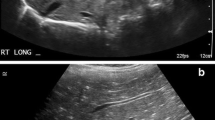Abstract
Background
Recent clinical trials in adults and children have shown that uncomplicated acute appendicitis can be successfully treated with antibiotics alone. As treatment strategies for acute appendicitis diverge, accurate preoperative diagnosis of complicated appendicitis and appendiceal perforation has become increasingly important for clinical decision-making.
Objective
To examine diagnostic performance of ultrasound for detecting perforated appendicitis in a single institution using a standardized technique.
Materials and methods
In this retrospective single-center study we evaluated 113 ultrasounds from pediatric patients who underwent appendectomy between November 2014 and December 2015. All ultrasounds were performed using a standardized US protocol including still and cine images of all four abdominal quadrants, with more targeted evaluation of the right lower quadrant (RLQ) using graded compression technique. We compared US findings to intraoperative diagnosis of non-perforated or perforated acute appendicitis.
Results
The standardized image protocol generated a reproducible set of ultrasound images in all cases. The most common primary appendiceal finding on US in perforated appendicitis was appendix wall thickening >3 mm (54%, 171/314) and most common secondary finding was echogenic mesenteric fat (75%, 237/314). Thinning of the appendix wall and loculated fluid collection in the right lower quadrant were both highly specific (>90%) for perforation.
Conclusion
The diagnostic performance of ultrasound using a standardized US technique was similar to that reported in prior studies for detecting perforated appendicitis. Despite low sensitivity, individual ultrasound findings and overall diagnostic impression of “evidence of appendix perforation” remain highly specific.




Similar content being viewed by others
References
Somme S, Bronsert M, Morrato E et al (2013) Frequency and variety of inpatient pediatric surgical procedures in the United States. Pediatrics 132:1466–1472
Groter RR, van der Lee JH, Cense HA et al (2015) Initial antibiotic treatment for acute simple appendicitis in children is safe: short-term results from a multicenter, prospective cohort study. Surgery 157:916–923
Armstrong J, Merritt N, Jones S et al (2014) Non-operative management of early acute appendicitis in children: it is safe and effective? J Pediatr Surg 49:782–785
Tanaka Y, Uchida H, Kawashima H et al (2015) Long-term outcomes of operative versus nonoperative treatment for uncomplicated appendicitis. J Pediatr Surg 50:1893e–1897
Mahida JB, Lodwick DL, Nacion KM et al (2016) High failure rate of non-operative management of acute appendicitis with an appendicolith in children. J Pediatr Surg 51:908–911
Minneci PC, Sulkowski JP, Nacion KM et al (2014) Feasibility of a nonoperative management strategy for uncomplicated acute appendicitis in children. J Am Coll Surg 219:272–279
Koberlein GC, Trout AT, Rigsby CK et al (2018) American College of Radiology ACR appropriateness criteria suspected appendicitis — child. https://acsearch.acr.org/docs/3105874/Narrative. Accessed 20 April 2019
Gongidi P, Bellah RD (2017) Ultrasound of the pediatric appendix. Pediatric Radiol 47:1091–1100
Tulin-Silver S, Bab J, Pinkney L et al (2015) The challenging ultrasound diagnosis of perforated appendicitis in children: constellations of sonographic findings improve specificity. Pediatr Radiol 45:820–830
Blumfield E, Yang D, Grossman J (2017) Scoring system for differentiating perforated and non-perforated pediatric appendicitis. Emerg Radiol 4:547–554
Goldin AB, Khanna P, Thapa M et al (2011) Revised ultrasound criteria for appendicitis in children improve diagnostic accuracy. Pediatr Radiol 41:993–999
Partain KN, Patel A, Travers C et al (2016) Secondary signs may improve the diagnostic accuracy of equivocal ultrasounds for suspected appendicitis in children. J Pediatr Surg 51:1655–1660
Gonzalez DO, Lawrence AE, Cooper JN et al (2018) Can ultrasound reliably identify complicated appendicitis in children? J Surg Res 229:76–81
St. Peter SD, Sharp SW, Holcomn GW, Ostlie DJ (2008) An evidence-based definition of perforated appendicitis derived from a prospective randomized trial. J Pediatr Surg 43:2242–2245
Altman DG (1991) Inter-rater agreement. In: Practical statistics for medical research. Chapman & Hall, Boca Raton, pp 403–404
Carpenter JL, Orth RC, Zhang W et al (2017) Diagnostic performance of US for differentiating perforated from non-perforated pediatric appendicitis: a prospective cohort study. Radiology 282:835–841
Williams RF, Blakely ML, Fischer PE et al (2009) Diagnosing ruptured appendicitis pre-operative in pediatric patients. J Am Coll Surg 208:819–825
Young KA, Neuhaus NM, Fluck M et al (2018) Outcomes of complicated appendicitis: is conservative management as smooth as it seems? Am J Surg 215:586–692
Waite S, Scot J, Gale B et al (2017) Interpretive error in radiology. AJR Am J Roentgenol 208:739–749
Leeuwenburgh MM, Wiezer MJ, Wiarda BM et al (2014) Accuracy of MRI compared with ultrasound imaging and selective use of CT to discriminate simple from perforated appendicitis. Br J Surg 101:e147–e155
Repplinger MD, Pickhardt PJ, Robbins JB et al (2018) Prospective comparison of diagnostic accuracy of MR imaging versus CT for acute appendicitis. Radiology 288:467–475
Zens TJ, Rogers AP, Riedesel EL et al (2018) The cost-effectiveness and utility of a “quick MRI” for the evaluation of intra-abdominal abscess after acute appendicitis in the pediatric population. J Pediatr Surg 53:1168–1174
Author information
Authors and Affiliations
Corresponding author
Ethics declarations
Conflicts of interest
None
Additional information
Publisher’s note
Springer Nature remains neutral with regard to jurisdictional claims in published maps and institutional affiliations.
Rights and permissions
About this article
Cite this article
Riedesel, E.L., Weber, B.C., Shore, M.W. et al. Diagnostic performance of standardized ultrasound protocol for detecting perforation in pediatric appendicitis. Pediatr Radiol 49, 1726–1734 (2019). https://doi.org/10.1007/s00247-019-04475-5
Received:
Revised:
Accepted:
Published:
Issue Date:
DOI: https://doi.org/10.1007/s00247-019-04475-5




